Mobile cranes were derived from the early steam cranes, and crawler cranes. They have a huge variety of uses in construction. And form an important part of construction plant history, as without then a lot of current machine designs are directly descended from.
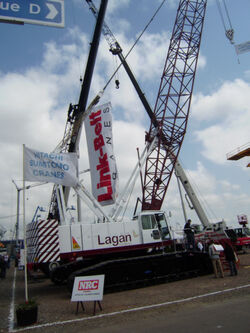
Cranes on Display at SED 2008
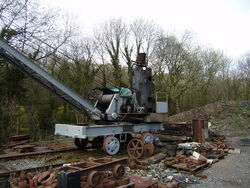
A Grafton Steam Crane at Ironbridge Museum (Incomplete) awaiting restoration
Definition of a crane
A crane is a mechanical lifting device equipped with a winder, wire ropes and sheaves that can be used both to lift and lower materials and to move them horizontally. It uses one or more simple machines to create mechanical advantage and thus move loads beyond the normal capability of a human. Cranes are commonly employed in the transport industry for the loading and unloading of freight; in the construction industry for the movement of materials; and in the manufacturing industry for the assembling of heavy equipment.
Mobile crane
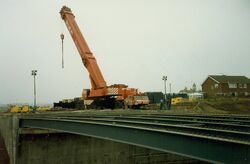
A large Gottwald telescopic mobile crane with demountable boom erecting 20m long bridge girders
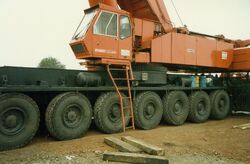
A Gottwald 400 ton mobile crane, showing 7 of the 9 axles. the boom is carried on a separate transporter.
The most basic type of mobile crane consists of a steel truss or telescopic boom mounted on a mobile platform, which may be rail, wheeled (including "truck" carriers) or caterpillar tracks. The boom is hinged at the bottom, and can be raised and lowered by cables or by hydraulic cylinders. A hook is suspended from the top of the boom by wire rope and sheaves. The wire ropes are operated by whatever prime movers the designers have available, operating through a variety of transmissions. Steam engines, electric motors and internal combustion engines (IC) have all been used. Older cranes' transmissions tended to be clutches. This was later modified when using IC engines to match the steam engines "max torque at zero speed" characteristic by the addition of a hydrokinetic element culminating in controlled torque converters. The operational advantages of this arrangement can now be achieved by electronic control of hydrostatic drives, which for size and other considerations is becoming standard. Some examples of this type of crane can be converted to a demolition crane by adding a demolition ball, or to an earthmover by adding a clamshell bucket or a dragline and scoop, although design details can limit their effectiveness.
To increase the horizontal reach of the hoist, the boom may be extended by adding a jib to the top. The jib can be fixed or, in more complex cranes, luffing (that is, able to be raised and lowered).
Telescopic crane
A telescopic crane has a boom that consists of a number of tubes fitted one inside the other. A hydraulic or other powered mechanism extends or retracts the tubes to increase or decrease the total length of the boom. These types of booms are often used for short term construction projects, rescue jobs, lifting boats in and out of the water, etc. The relative compactness of telescopic booms make them adaptable for many mobile applications, often of short duration.
Truck-mounted crane
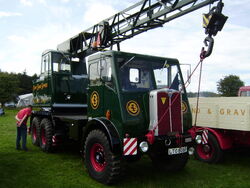
Early Coles Crane mounted on AEC chassis
A crane mounted on a truck carrier provides the mobility for this type of crane.
Generally, these cranes are designed to be able to travel on streets and highways, eliminating the need for special equipment to transport a crane to the jobsite. When working on the jobsite, outriggers are extended horizontally from the chassis then down vertically to level and stabilize the crane while stationary and hoisting. Many truck cranes possess limited slow-travelling capability (just a few miles per hour) while suspending a load. Great care must be taken not to swing the load sideways from the direction of travel, as most of the anti-tipping stability then lies in the strength and stiffness of the chassis suspension. Most cranes of this type also have moving counterweights for stabilization beyond that of the outriggers. Loads suspended directly over the rear remain more stable, as most of the weight of the truck crane itself then acts as a counterweight to the load. Factory-calculated charts (or electronic safeguards) are used by the crane operator to determine the maximum safe loads for stationary (outriggered) work as well as pick and carry work (on-rubber) and safe travelling speeds.
Truck cranes range in lifting capacity from about 5 US tons to about 1300 US tons.
Rough Terrain crane
A crane mounted on an undercarriage with four rubber tires that is designed for pick-and-carry operations and for off-road and "rough terrain" applications. Outriggers that extend horizontally and vertically are used to level and stabilize the crane for hoisting.
These telescopic cranes are single-engine machines where the same engine is used for powering the undercarriage as is used for powering the crane, similar to a crawler crane. However, in a rough terrain crane, the engine is usually mounted in the undercarriage rather than in the upper, like the crawler crane.
Crawler crane
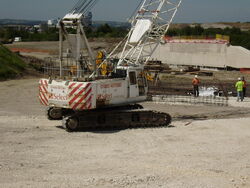
Large crawler crane as support to piling rig (model unkwown)
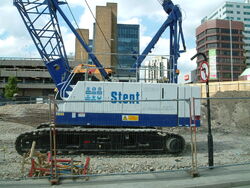
A Moden Hydraulic Crawler Crane in "Stent" piling Colours on a construction site.
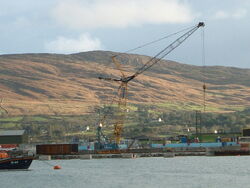
A large Dockside crawler crane with fly jib in Ireland
A crawler is a crane mounted on an undercarriage with a set of tracks (also called crawlers)that provide for the stability and mobility of the crane. Crawler cranes have both advantages and disadvantages depending on their intended use. The main advantage of a crawler is that they can move on site and perform lifts with very little set-up, as the crane is stable on its tracks with no outriggers. In addition, a crawler crane is capable of traveling with a load. The main disadvantage of a crawler crane is that they are very heavy, and cannot easily be moved from one job site to the next without significant expense. Typically, a large crawler must be disassembled and moved by trucks, rail cars or ships to be transported to its next location.
Crawler cranes range in lifting capacity from about 40 US tons to 3500 US tons.
"Spider" cranes
Are a modern compact crane on a crawler chassis that can in some cases pass through a door way. These fold up ultra compact, but the out rigger legs fold out like a "spider" to give a wide spaced but stable support. Often being used inside buildings or on the roof to install plant or glazing. capacities range from .5 ton to about 10 ton for larger models, but vary depending on outrigger configuration. Being on tracks they have low ground pressure for travelling into working site and can be positioned easily by remote control. They have been used in places like Nuclear power stations for maintenance works, instead of setting up mobile gantries which is aurquide due to weight of components,
Early cranes
The first mobile cranes on vehicles were mounted on Steam Tractors, in the 1800's. Following the introduction of the Tractor and Crawler Tractor these were soon adapted to fit similar arms and a winch attached to the drive shaft soon followed.
Other Cranes
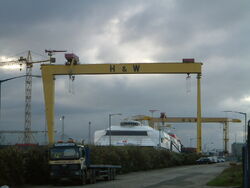
The pair of Goliath Cranes at Harland & Wolf.
A modern Jost Tower crane with Hydraulic elevating Jib
- Goliath type are large mobile gantries that run on rails, usually used in shipyards and large engineering works. The best know being the pair at "Harland & Wolf" in Belfast. The largest was in Finland till it was sold to the Koreans.
- Rail cranes, built by Cowans-Sheldon in Carlise, started as steam cranes.
- Dock Cranes, Built by Stothert & Pitt of Bath.
- Tower Cranes, Built by Comdil (Terex), Jost, Liebherr, Potain, Wolff and others.
- Scotch Derricks, A type of crane that was common in yards and Quaries. A central cab and winch mounted on a post supported by bracing legs that are anchored down by balast weight. The desighn alows the boom and hook to cover a 250 degree arch. Some versions were used to errect early tall building and were mounted on the structure and grew with the building.

A scotch derrick on the Quay side in Waterford Ireland used for loading and unloading ships.
Manufactures
- Allen of Oxford
- American
- Casagrande - crawler cranes & piling rigs
- Chaseside - compact tractor mounted yard cranes.
- Clarke Chapman & Co. Ltd became NEI & now owns Stothert & Pitt
- Coles taken over by Grove
- Henry Cooch cranes
- Demag
- Faun now part of Tadano
- Gottwald
- Grove
- Hitachi
- Hydrocon (Lambert Engineering)
- IHI
- Jones Cranes
- Koehring
- Krupp takem over by Grove
- Neil F. Lampson
- Liebherr
- Lima
- Link-Belt
- Manitowoc
- Marion
- NCK Rapier formerly (NCK)
- R.H. Neal & Co.
- P&H Cranes now part of Terex
- PPM now part of Terex
- Priestman
- Ransomes & Rapier - steam cranes, crawler cranes
- RB Cranes / Ruston-Bucyrus
- Ruston Proctor - steam cranes
- Cowan Sheldon
- Sennebogen
- Thomas Smith & Sons (Rodley) Ltd
- Steel & Co. Ltd - took over Coles.
- Stothert & Pitt
- Sumitomo
- Tadano
- Taylor & Hubbard rail cranes
- F Taylor & Sons Merged woyh Coles.
- Terex now owners of a number of other famous brands.
UK Crane Hire firms
- Ainscougth
- Baldwin
- Crane Services
- Goldsheild
- Graystone White and Sparrow (GWS)
- Hewden Stuart
- Interlift
- Mammoet
- Sarens
- Scotts
- Scott Greenham
- Sparrows
- Stanley Davis
- Terranova
References
- wikipedia
- The History of Cranes by Heinz-Herbert Cohrs, ISBN 0-9530219-1-2
links
- http://www.kranliste.dk/ Crane details
| This page uses some content from Wikipedia. The original article was at Crane (machine). The list of authors can be seen in the page history. As with Tractor & Construction Plant Wiki, the text of Wikipedia is available under the Creative Commons by Attribution License and/or GNU Free Documentation License. Please check page history for when the original article was copied to Wikia |